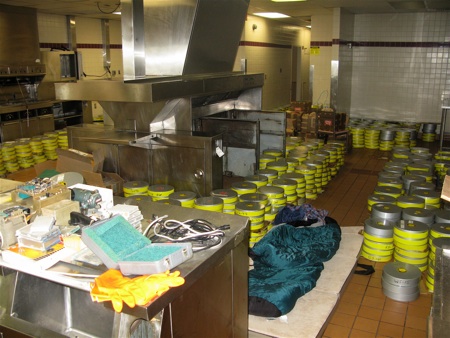Digital Recovery of Moon Images
It is very difficult to keep digital data moving forward in time. I call that movage and its hard to do. Exhibit A: “Mankind’s first up-close photos of the lunar landscape have been rescued from four decades of dusty storage.”
Steve Jurvetson writes:
Behind the counter of an abandoned McDonalds lie 48,000 lbs of 70mm tape the only copy of extremely high-resolution images of the moon.
Forty years ago, unmanned lunar orbiters circled the moon taking extremely high-res photos of the surface to plan landing spots for Apollo 11 onward… In this McDonalds, the only copy of that data is about to be resurrected. These tapes were recorded 40 years ago as part of the Apollo program to map the lunar surface to plan landing spots for Apollo 11 onward. They have never been seen by the public because at the time, they were classified as they reveal the extreme precision of our spy satellites. Instead, all we have ever seen are the grainy photo-of-a-photo images that were released to the public.
The spacecraft did not ship this film back to Earth. Instead, they developed the film on the Lunar Orbiter and then raster scanned the negatives with a 5 micron spot (200 lines/millimeter resolution) and beamed the data back to Earth using yet-to-be-patented-by-others lossless analog compression. Three ground stations on Earth (one was in Madrid) recorded the transmissions on these magnetic tapes.
Recovering the data has proven to be very difficult, requiring technological archeology. The only working version of the Ampex tape player ($300K when new) was discovered in a chicken coop and restored with the help of the original designer. There is only one person on Earth who still refurbishes these tape heads, and he is retiring this year. The skills to read this data archive are on the cusp of disappearing forever.
Some of the applications of this project, beyond accessing the best images of the moon ever taken, are to look for new landing sites for the new Google Lunar X-Prize robo-landers, and to compare the new craters on the moon today to 40 years ago, a measure of micrometeorite flux and risk to future lunar operations.

From KTVU:
In an abandoned McDonald’s restaurant on NASA Ames property in Mountain View, a pirate flag is taped to the window. Inside, it gets even stranger. Three researchers huddle around a wheezing 45-year-old Ampex FR-900A tape machine, a one-of-a-kind reel to reel 2-inch model designed to record data for the National Security Agency. It now sits where people used to wolf down Big Macs. Behind the counter, where the fry-tubs and refrigerators used to be, one-thousand five hundred 14-inch diameter tape reels are clustered in five piles. Each reel has a two letter identifier followed by three numbers. “These tapes hold the best images of the moon ever taken, even to today,” says Dennis Wingo, a lanky 55-year-old engineering physicist who heads the Lunar Orbiter Image Recovery Project.
From Moonviews:
Those images include a high-resolution version of “Earthrise,” the first picture of the Earth from the Moon’s vantage point. Time Magazine has called this image “the photo of the century.” The tapes also contain the first stereo imagery of the Moon’s surface. Indeed, these are some of the best images of the Moon ever taken, far superior from those received from the Hubble telescope.
Astonishingly, all of the images stored on the 1,500 14-inch diameter tape reels were nearly destroyed. With its focus turned to the Apollo mission, NASA saw little further use for the tapes. Fortunately, Nancy Evans, co-founder of NASA Planetary Data Systems, convinced her superiors at the Jet Propulsion Laboratory to retain the tapes. Evans also salvaged three refrigerator-sized FR-900 tape drives, which she stored in her own garage for two decades. Evans and Mark Nelson, of Caltech, managed to get a few tape drives running but their project ultimately folded. NASA turned down her requests for assistance after placing an estimate of $6 million on the cost to restore the data.
More details of this unlikely rescue operation from Dr. X
This project started in the late 1980’s when the National Space Science Data Center (NSSDC) discovered a cache of the only known remaining set of Lunar Orbiter tapes in existence stored in a “salt mine.” The story there is that there are abandon salt mines that store government records, as the temperature and humidity are stable. There was some documentation attached indicating what they were and that JPL should be notified as to what their ultimate fate should be. JPL took possession of them in about 1988 or so, as there was some interest in recovering the data so that the images could be digitized and made available to the general public as the pictures were then a bulky 2000, 28″ x 30″ prints. The problem at that point was that no one knew what technology created the tapes so the format and method was unknown. At the time a private consulting firm became aware of the project and decided to research the issue with the purpose of proposing a data recovery project. After amassing all the Lunar Orbiter literature available, it was determined that the Ampex FR900 tape recorder (the first real video tape recorder), was used to create the tapes. More importantly it was revealed that the data was in an analog format with the video in a format called “Vestigial Sideband Filtered”, slow scan TV. This knowledge set about the search for any source of FR900 tape drives. The search covered NASA sites, Vandenberg’s Pacific Missile Range at Kwajalein, the CIA and Egland AFB’s radar test site in Florida. Ultimately a total of four tape drives were obtained and as far as is known, are the only remaining drives of their type in the world.


